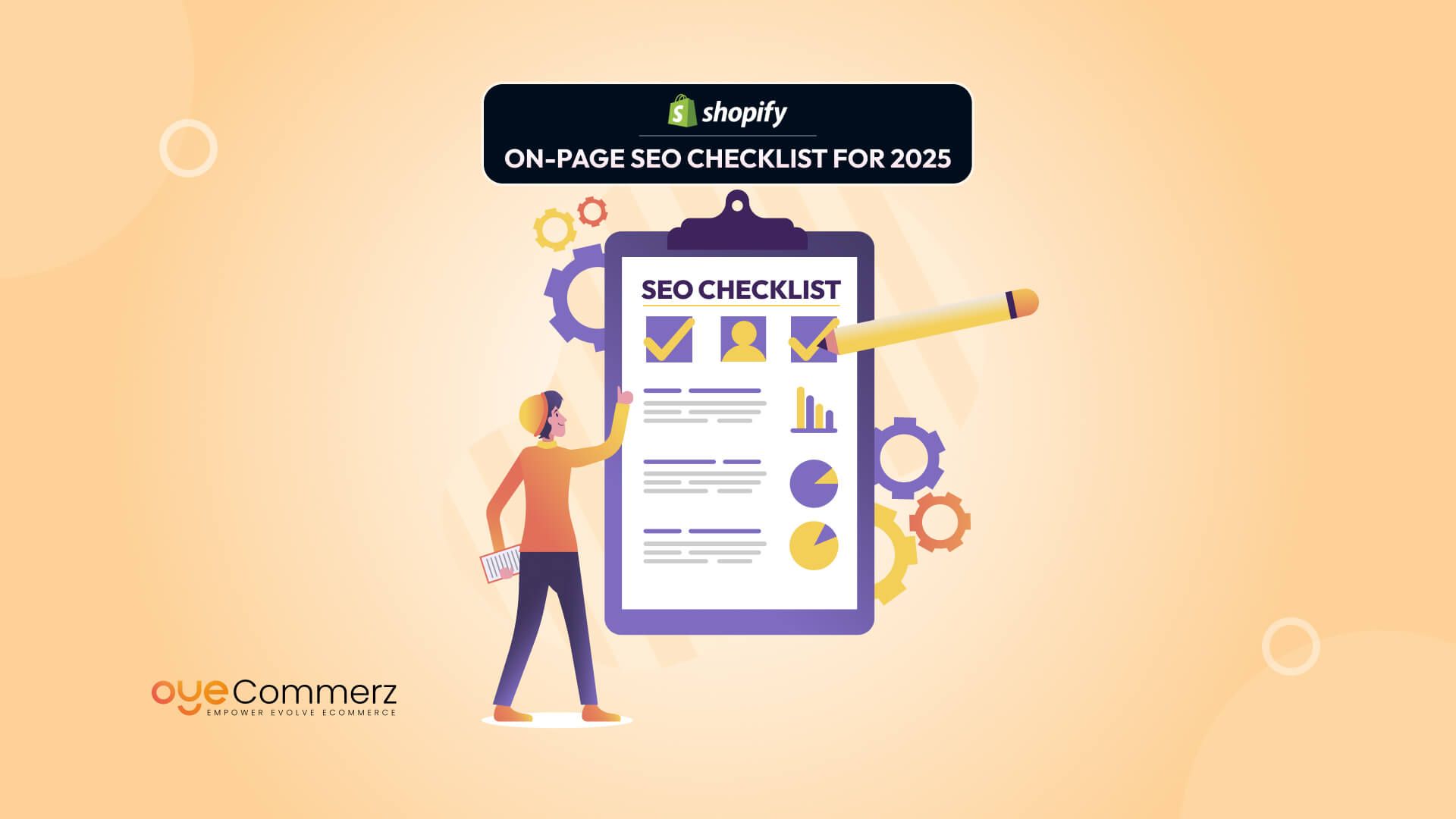Is your Shopify store showing up on Google when customers search for products like yours? Or is it getting lost among your competitors? In 2025, on-page SEO is no longer just a nice-to-have; it’s essential for driving organic traffic and growing your online store. Shoppers today use voice search, long questions, and visual tools to find exactly what they want. At the same time, Google’s algorithm has become smarter with AI, focusing more on helpful content, fast-loading pages, and a great user experience. That means your store needs to be clear, relevant, and optimized to meet both search engine and customer needs.
Whether you’re running a small boutique or a growing eCommerce brand, this on-page SEO checklist will help you stay ahead. Follow these simple steps to rank higher in search results, bring more visitors to your site, and increase your conversions all without spending more on ads. Let’s dive in.
Table of Contents
ToggleWhat Is On-Page SEO and Why It Matters for Shopify?
On-page SEO refers to the practice of optimizing elements on your website to improve its visibility and ranking in search engine results pages (SERPs). For Shopify stores, on-page SEO plays a crucial role in ensuring that search engines can crawl, index, and understand your product pages, leading to better rankings and increased organic traffic. On-page SEO focuses on both content and technical aspects of a webpage to improve its relevance and performance.
Key Elements of On-Page SEO for Shopify Stores
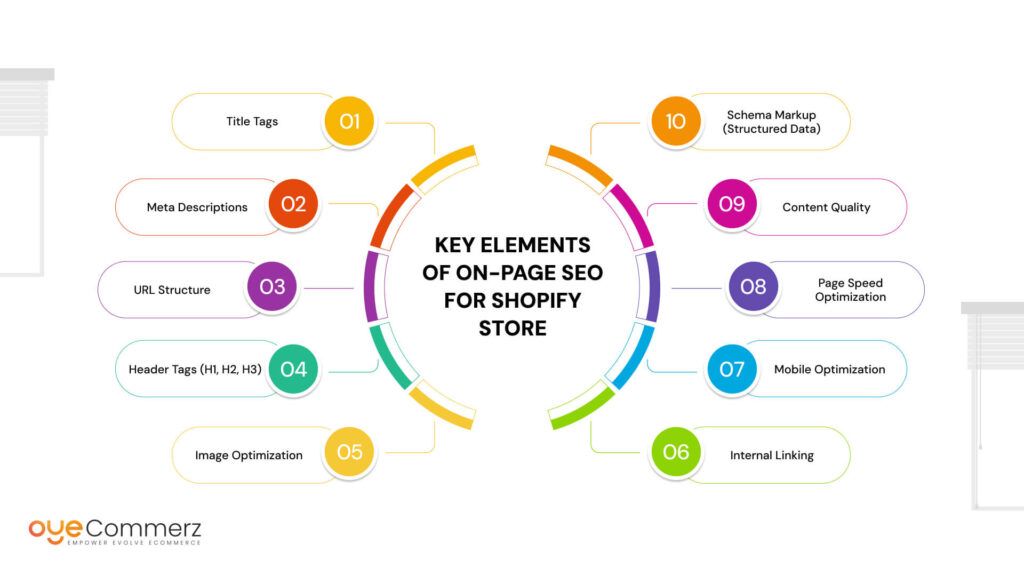
- Title Tags
Title tags are one of the most important on-page SEO factors. These are the clickable headlines displayed in search engine results. For Shopify stores, ensure each product page, category, and blog post has a unique title that includes relevant keywords. Keep it concise (50-60 characters) while still making it descriptive. - Meta Descriptions
The meta description is the short paragraph that appears under the title tag in search results. While it doesn’t directly affect rankings, a well-crafted meta description can encourage higher click-through rates (CTR). Include relevant keywords and a compelling call-to-action to entice users. - URL Structure
Clean, descriptive URLs help both search engines and users understand the content of a page. Shopify generates URLs based on product names or collections, but you can often edit them to make them more SEO-friendly. Keep URLs short, include keywords, and avoid unnecessary characters or numbers. - Header Tags (H1, H2, H3)
Header tags structure your content and provide a hierarchy for both users and search engines. The H1 tag should be used for the main heading, typically your product or page title. H2 and H3 tags are used for subheadings. Ensure your headings are optimized with relevant keywords and reflect the content of the page. - Image Optimization
Product images are essential for an eCommerce store, but they can also affect your SEO if not properly optimized. Shopify allows you to add alt text to images, which describes what the image is about. Alt text helps search engines understand the image content and provides accessibility benefits. Compress images to reduce page load time, which also contributes to a better user experience and SEO ranking. - Internal Linking
Internal links connect related pages on your Shopify store, helping both users and search engines navigate your site. Internal linking improves the SEO of less visible pages and keeps users engaged longer. Make sure product descriptions and blog posts link to other relevant pages within your store. - Mobile Optimization
With mobile traffic surpassing desktop usage, having a mobile-friendly website is critical for SEO. Shopify themes are typically responsive, meaning they automatically adjust to fit different screen sizes. However, ensure your mobile layout is smooth, and the content remains easy to read and interact with. - Page Speed Optimization
Page load speed is a critical ranking factor. Shopify stores can benefit from using optimized images, minimalistic design elements, and fast loading third-party apps. Consider using a content delivery network (CDN) and enabling caching to speed up the loading time of your store. - Content Quality
High-quality content is essential for on-page SEO. Product descriptions, blog posts, and landing pages should be well-written, informative, and relevant to your audience. For Shopify, ensure each product page has a detailed description that answers potential customer questions and highlights unique selling points. - Schema Markup (Structured Data)
Schema markup helps search engines understand your content in a more structured way. For Shopify stores, this could mean adding rich snippets like star ratings, price, and availability directly in the search results, improving visibility and CTR.
Why On-Page SEO Matters for Shopify
- Better Search Rankings
On-page SEO helps search engines understand what your store is about and determines whether your pages are relevant to a user’s search query. Optimizing these elements increases your chances of ranking higher in the SERPs, which can drive more organic traffic to your Shopify store. - Improved User Experience
Many on-page SEO practices, such as mobile optimization, fast page loading, and clean URLs, also enhance the user experience. A better user experience leads to higher engagement, lower bounce rates, and higher conversion rates. - Increased Conversion Rates
Optimized pages with compelling content, clear calls-to-action, and a smooth shopping experience can boost conversion rates. When your product pages are properly optimized for SEO, it not only helps attract more visitors but also improves your chances of converting them into customers. - Cost-Effective Marketing
Organic search traffic is free. By investing in on-page SEO, you can improve your rankings without the need for paid ads, thus making it a cost-effective strategy for long-term business growth. - Competitive Advantage
Many Shopify stores overlook on-page SEO, leaving gaps that you can take advantage of. By ensuring your store is fully optimized, you can outperform competitors who neglect this essential SEO practice.
2025 On-Page SEO Trends Shopify Merchants Should Know
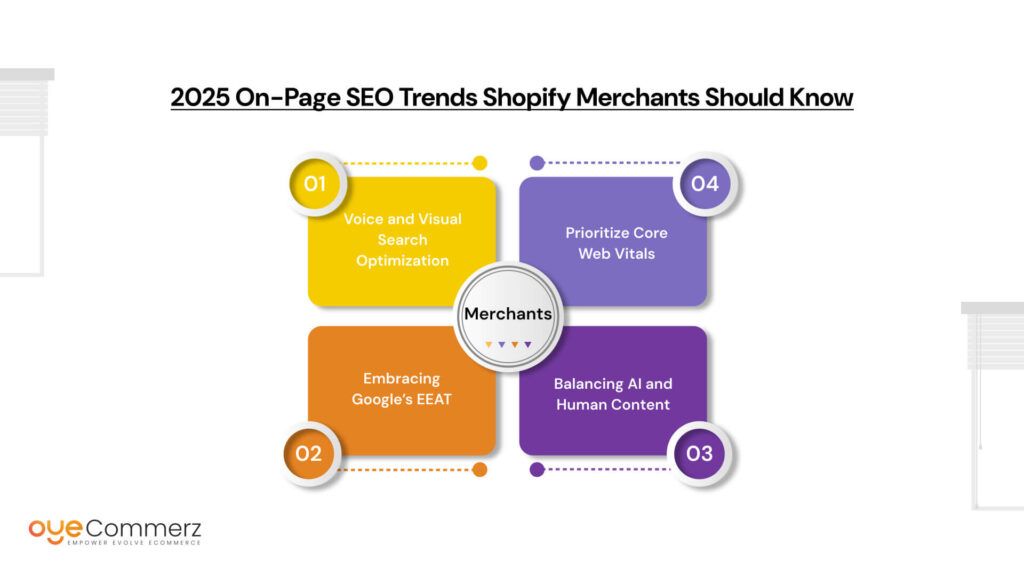
Staying on top of SEO trends is vital for Shopify store success. In 2025, on-page SEO continues to evolve, with user intent and experience at its core. Here are key trends to focus on:
1. Voice and Visual Search Optimization
Voice search is rising with smart assistants. Optimize content using natural, long-tail, question-based keywords in product descriptions and FAQs.
Visual search is also gaining traction. Use high-quality images with descriptive alt text and file names, and implement structured data to improve discoverability.
2. Embracing Google’s EEAT
Google prioritizes content with Experience, Expertise, Authoritativeness, and Trustworthiness.
- Experience: Include real customer reviews and testimonials.
- Expertise: Publish content written or reviewed by subject matter experts.
- Authoritativeness: Earn backlinks from credible sources.
- Trustworthiness: Display clear return policies, secure payments, and trust badges to build shopper confidence.
3. Balancing AI and Human Content
AI tools can streamline content creation, but human input is still key. Use AI to draft product descriptions or blogs, then personalize them with brand tone, storytelling, and value-driven insights. This hybrid approach improves SEO and builds user trust.
4. Prioritize Core Web Vitals
Google’s page experience metrics LCP, FID, and CLS directly affect rankings.
- Optimize images and server speed for faster LCP.
- Reduce JavaScript for better FID.
Prevent layout shifts to improve CLS.
A fast, stable, and interactive site enhances both SEO and the customer journey.
The Ultimate Shopify On-Page SEO Checklist for 2025
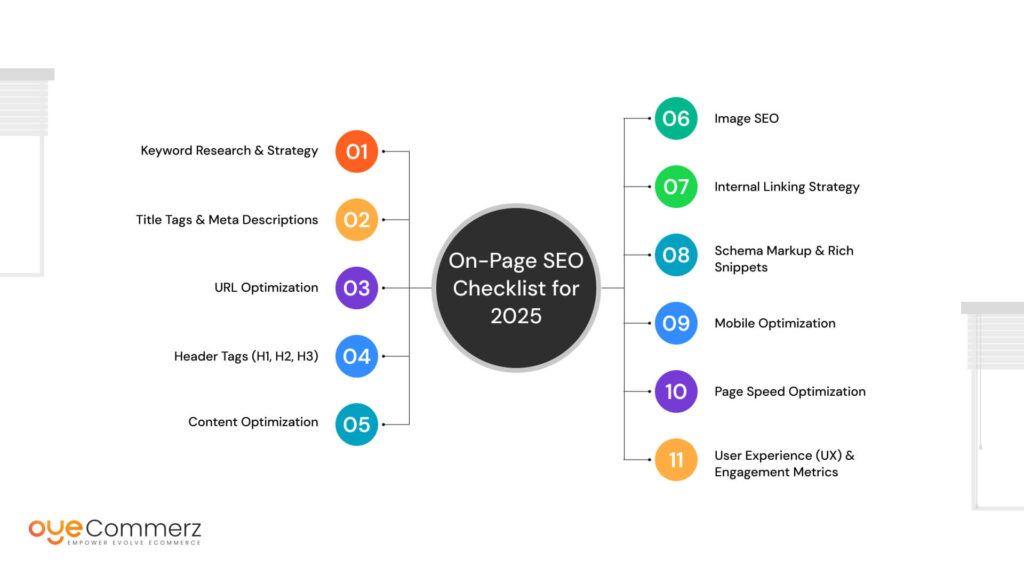
Optimizing your Shopify store for on-page SEO is essential to increase visibility, improve user experience, and drive more sales. Use this comprehensive checklist to ensure you’re covering all the crucial elements of SEO in 2025.
A. Keyword Research & Strategy
- Use of Long-Tail and Semantic Keywords
Long-tail keywords (e.g., “best eco-friendly yoga mats for beginners”) help target niche audiences with high conversion potential. Semantic keywords are related terms that improve the context of your content for search engines. Use tools like ChatGPT to generate related keywords for product descriptions and blog content. - Tools to Use in 2025
- Ahrefs: To discover keyword ideas and analyze competitors.
- Google Search Console: To track performance and identify high-ranking keywords.
- SurferSEO: Helps optimize content for SEO, making it easier to rank for specific keywords.
- ChatGPT: Assists with keyword brainstorming, generating content around keywords, and creating SEO-optimized copy.
- Mapping Keywords to Different Page Types
- Product Pages: Focus on transactional keywords.
- Collection Pages: Use broader, category-based keywords.
- Blog Posts: Target informational and long-tail keywords to drive organic traffic.
B. Title Tags & Meta Descriptions
- Writing Irresistible, Keyword-Optimized Titles Under 60 Characters
Include primary keywords in your titles while creating a compelling hook for users. Ensure the title remains under 60 characters to avoid truncation in search results. - Crafting Compelling Meta Descriptions That Increase CTR
Meta descriptions should be concise (under 160 characters) and provide a clear summary of the content. Include relevant keywords and add a call to action to boost clicks (e.g., “Shop now for the best prices on eco-friendly sneakers”). - Shopify Apps That Can Help Automate/Update Meta Tags
- SEO Meta Manager: Helps manage title tags and meta descriptions efficiently.
- Plug in SEO: Scans your store and offers actionable recommendations for on-page SEO improvements.
C. URL Optimization
- Keeping URLs Short, Readable, and Keyword-Rich
Use descriptive, clean URLs (e.g., “/organic-cotton-t-shirt” instead of “/product-12345”). Ensure URLs are concise and incorporate relevant keywords. - Avoiding Duplicate URLs
Shopify may create duplicate URLs due to product collections or variations. Regularly check for and address any duplication issues. - Canonical Tags to Fix Duplicate Content
Implement canonical tags to indicate the preferred version of a page, helping to prevent penalties for duplicate content and consolidating link equity.
D. Header Tags (H1, H2, H3)
- Only One H1 Per Page — How to Check and Edit It on Shopify Themes
Each page should only have one H1 tag, typically the product or page title. Use Shopify’s theme editor or inspect code to ensure it’s set correctly. - Using H2s and H3s for Readability and SEO Relevance
Structure your content with H2 and H3 headers to break up text. These should reflect the content’s main topics and include relevant keywords. - Common Header Mistakes on Product Pages
Avoid using multiple H1 tags or missing headers. Use H2 and H3 for sections like “Product Features,” “Customer Reviews,” and “Shipping Information.”
E. Content Optimization
- Creating Unique Product and Collection Descriptions
Write detailed, unique descriptions for each product. Avoid generic supplier descriptions to make your product pages stand out and rank higher in search results. - Use of LSI (Latent Semantic Indexing) Keywords
Incorporate related terms and synonyms to strengthen the content’s context. For example, for “organic cotton t-shirts,” use LSI keywords like “sustainable fabric,” “eco-friendly apparel,” and “green clothing.” - Image-to-Text Balance for Readability
Ensure a good balance between text and images. Too many images can hinder page speed and SEO performance, so ensure the text remains dominant for better ranking. - Avoiding Duplicate Content (Especially on Variants)
Product variants should have unique descriptions to avoid content duplication. Differentiate sizes, colors, or versions with distinct images or text.
F. Image SEO
- Naming Images Descriptively
Name image files descriptively with keywords (e.g., “organic-cotton-tshirt-men.jpg”) instead of generic names like “IMG12345.jpg.” - Using Alt Text for Accessibility and SEO
Add descriptive alt text for each image. This improves accessibility and helps search engines index your images for SEO. - Next-Gen Formats (WebP) and Compressing for Faster Load Times
Use WebP for faster load times and compression without sacrificing quality. Apps like Crush.pics can help with image compression.
G. Internal Linking Strategy
- Linking Between Blogs, Products, and Collections
Create a web of internal links between your product pages, blog posts, and collections to improve SEO and assist users in finding relevant products. - Importance of Breadcrumbs and Navigation Structure
Use breadcrumbs to make it easier for users to navigate your store and help search engines understand your site’s structure. - Using Related Product Sections Effectively
Include a “Related Products” section on product pages to encourage users to explore additional products, increasing engagement and time spent on the site.
H. Schema Markup & Rich Snippets
- Adding Product Schema (Price, Availability, Reviews)
Use schema markup to display additional product details like price, availability, and reviews directly in search results. - Blog Schema for Enhanced Visibility
Implement Article Schema or BlogPosting Schema to improve the visibility of your blog posts and enhance click-through rates from search engines. - Recommended Tools and Apps for Structured Data on Shopify
- JSON-LD for SEO: A simple app to add schema markup to product pages.
- Schema App Structured Data: Automates schema markup for product pages, blogs, and reviews.
I. Mobile Optimization
- Responsive Theme Design in 2025
Ensure your Shopify theme is responsive, meaning it adapts seamlessly to different screen sizes, particularly mobile devices. - Testing with Google’s Mobile-Friendly Test
Regularly test your store with Google’s Mobile-Friendly Test tool to ensure it’s fully optimized for mobile users. - Minimizing Pop-Ups and Improving Mobile UI/UX
Limit pop-ups on mobile and optimize your mobile user interface for easy navigation and quick load times.
J. Page Speed Optimization
- Shopify-Specific Tips: Reducing App Bloat, Lazy Loading Images
Remove unnecessary apps that slow down your site. Implement lazy loading for images to only load them when visible on the screen. - Tools to Test Speed (Lighthouse, GTmetrix, PageSpeed Insights)
Use Google Lighthouse, GTmetrix, and PageSpeed Insights to identify speed issues and implement fixes. - Choosing Fast, Lightweight Themes and Optimizing Liquid Code
Select a theme known for fast loading times. Optimize your Shopify Liquid code to reduce unnecessary requests and improve performance.
K. User Experience (UX) & Engagement Metrics
- Clear CTAs, Fast Checkout, Sticky Navigation
Ensure your CTAs (Call to Action) are clear, your checkout process is simple, and sticky navigation is enabled for easy access to key pages. - Time-on-Page and Bounce Rate Signals
Monitor your time-on-page and bounce rate using Google Analytics. High bounce rates may indicate issues with load times or content relevance. - Accessibility Improvements for SEO and UX
Make your store accessible to all users, including those with disabilities. Use accessible color schemes, alt text for images, and keyboard-friendly navigation to enhance both SEO and user experience.
Recommended Shopify SEO Tools and Apps for 2025
To help you optimize your Shopify store, it’s essential to use the right tools that can simplify and improve your SEO efforts. Below are some of the best SEO apps and tools for 2025 that can help you audit, track, and enhance your Shopify store’s SEO performance.
Best SEO Apps for Shopify
- Smart SEO
- Features: Smart SEO automatically generates meta tags, alt tags, and JSON-LD structured data for your products and pages, helping you improve your search engine visibility.
- Why Use It: It’s user-friendly, automates time-consuming tasks, and helps improve your website’s SEO health without requiring technical expertise.
- Plug In SEO
- Features: This app performs a comprehensive SEO audit of your Shopify store, providing insights and actionable recommendations. It also helps optimize title tags, meta descriptions, and alt tags.
- Why Use It: Great for beginners and experts alike, it’s a comprehensive SEO solution that helps ensure all critical on-page SEO aspects are covered.
- JSON-LD for SEO
- Features: This app adds structured data to your Shopify store, including rich snippets for product pages, reviews, prices, and availability, helping you stand out in search engine results.
- Why Use It: It simplifies the process of adding schema markup, which can improve the visibility of your products in search results, increasing CTR and conversions.
- SEO Booster
- Features: SEO Booster automatically generates SEO-friendly meta tags and alt text for your images. It also helps with title and description optimization, image compression, and redirects.
- Why Use It: Ideal for stores with large inventories, SEO Booster streamlines SEO optimization tasks, saving you time and effort.
- SEO Manager
- Features: Offers advanced features for title tag and meta description editing, 404 error tracking, Google Search Console integration, and more.
- Why Use It: This app is perfect for Shopify store owners who need a robust solution with extensive customization options for managing SEO.
Tools for Auditing and Tracking Progress
- Google Search Console
- Features: It provides insights into your website’s search performance, helping you identify issues like crawl errors, manual penalties, and the effectiveness of your SEO efforts.
- Why Use It: Google Search Console is essential for tracking keyword rankings, monitoring mobile usability, and understanding how Googlebot interacts with your store.
- Ahrefs
- Features: Ahrefs is an all-in-one SEO toolset that helps with keyword research, site audits, backlink analysis, and competitor research.
- Why Use It: For a more advanced SEO audit, Ahrefs provides detailed reports and allows you to monitor the health of your Shopify store, track progress, and identify opportunities for improvement.
- SEMrush
- Features: SEMrush is a powerful tool for keyword research, site audits, backlink analysis, and tracking the performance of your Shopify store in search engines.
- Why Use It: Known for its in-depth competitor analysis, SEMrush helps you stay ahead of your competitors by identifying the strategies that are working for them.
- Screaming Frog SEO Spider
- Features: This tool crawls your Shopify store’s URLs and helps you identify technical SEO issues, such as broken links, duplicate content, missing alt tags, and more.
- Why Use It: It’s excellent for conducting technical audits and finding issues on your site that may be affecting your SEO performance.
- GTmetrix
- Features: GTmetrix provides detailed analysis of your site’s loading speed and performance, offering suggestions for improving page load times.
- Why Use It: Page speed is a key ranking factor in SEO, and GTmetrix helps you understand exactly where to optimize to improve the speed of your Shopify store.
Browser Extensions and Plugins for On-Page Checks
- MozBar
- Features: MozBar is a browser extension that provides instant SEO insights for any webpage you visit. It shows page authority, domain authority, backlinks, and on-page elements like meta descriptions and title tags.
- Why Use It: It’s a quick and convenient tool for performing SEO checks on your own Shopify store as well as competitors’ sites.
- SEOquake
- Features: SEOquake is a free browser plugin that provides detailed SEO analysis, including metrics like Alexa rank, backlinks, keyword density, and page performance.
- Why Use It: It’s a quick tool for on-the-go SEO checks, helping you evaluate your store’s on-page SEO without needing to access a full SEO toolset.
- Keywords Everywhere
- Features: Keywords Everywhere shows you the search volume, competition, and cost-per-click (CPC) data for any keyword you search for.
- Why Use It: It’s an excellent extension for conducting quick keyword research directly from your browser, allowing you to identify profitable keywords in real time.
- Check My Links
- Features: This browser extension checks for broken links on your Shopify store or any webpage and helps you quickly identify issues.
- Why Use It: Broken links can hurt SEO and user experience, so using Check My Links is an easy way to ensure your store doesn’t have any broken links that might damage your SEO efforts.
- PageSpeed Insights by Google
- Features: PageSpeed Insights provides a detailed analysis of your website’s load speed and offers suggestions on how to improve it. It also highlights areas that need optimization.
Why Use It: Page speed is crucial for SEO, and this extension helps you quickly gauge how well your Shopify store is performing in terms of speed.
How to Track and Measure On-Page SEO Success
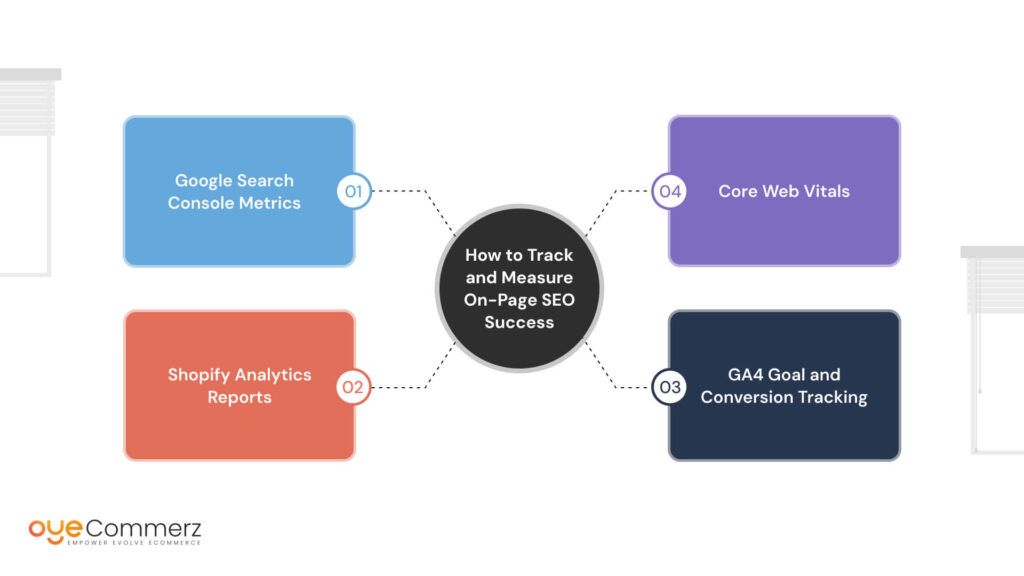
Google Search Console Metrics
- Key Metrics: Impressions, clicks, CTR, average position, coverage report, and mobile usability.
- How to Use It: Monitor keyword traffic, identify and fix crawl issues, and ensure mobile-friendliness for better rankings.
Shopify Analytics Reports
- Key Metrics: Sessions, sales and conversion rate, average order value (AOV), bounce rate, and product performance.
- How to Use It: Track traffic, conversions, and bounce rates to assess SEO effectiveness and identify areas for improvement in product pages and UX.
GA4 Goal and Conversion Tracking
- Key Metrics: Goal completions, ecommerce metrics (views, add-to-cart, purchases), user engagement (time on page), and event tracking.
- How to Use It: Set up goals to track actions like purchases and form submissions, monitor ecommerce performance, and evaluate engagement to refine your SEO strategy.
Core Web Vitals
- Key Metrics: Largest Contentful Paint (LCP), First Input Delay (FID), Cumulative Layout Shift (CLS).
- How to Use It: Use tools like Google PageSpeed Insights to monitor and improve load times, interactivity, and layout stability for better SEO rankings and user experience.
Supercharge Your Shopify SEO with Oyecommerz
Ready to rank higher and convert more customers? Partner with Oyecommerz, your trusted Shopify SEO experts. We specialize in optimizing Shopify stores for search engines, improving visibility, and driving sustainable eCommerce growth.
Let our team handle your on-page SEO, so you can focus on scaling your brand.
Get a Free Shopify SEO Audit and see how we can help your store perform better starting today.
Let's build your custom Shopify app today!
Conclusion
Effective on-page SEO is essential for the long-term success of your Shopify store, but it’s not a one-and-done task. It requires consistent effort, regular performance tracking, and a clear focus on user experience. Start by creating valuable, informative content that genuinely helps your audience then apply optimization strategies to boost visibility.
Keeping your approach simple, organized, and customer-first is key. Avoid over-optimization and focus on clarity, speed, and mobile usability. If you’re looking to scale your efforts, consider investing in professional Shopify SEO services to ensure your store stays competitive in search rankings.
For a complete growth strategy, pair your on-page work with Technical SEO, Content Marketing, and Link Building for Shopify to drive long-term organic traffic and higher conversions.
Frequently Asked Questions
On-page SEO refers to optimizing the elements on your website to improve its ranking in search engines. It includes aspects like content optimization, title tags, meta descriptions, header tags (H1, H2), URL structure, internal linking, image optimization (alt text), and ensuring the site is mobile-friendly and fast-loading. Essentially, it’s all about making sure your website content and structure are optimized for both users and search engines.
To do proper on-page SEO, follow these key steps:
Keyword Research: Identify the keywords relevant to your content.
Title Tags & Meta Descriptions: Ensure each page has a unique, descriptive title tag (under 60 characters) and a compelling meta description (under 160 characters).
Header Tags: Use proper H1, H2, and H3 tags to organize your content and include relevant keywords.
Content Optimization: Write high-quality, engaging content that naturally includes your target keywords. Focus on providing value to the user.
URL Structure: Create clean, descriptive, and SEO-friendly URLs.
Internal Linking: Link to other relevant pages within your website to improve navigation and spread link equity.
Image Optimization: Use alt text and compress images to reduce load time without compromising quality.
Mobile-Friendliness & Site Speed: Ensure your site is responsive and fast-loading to provide a positive user experience.
The 3 C’s of SEO are:
Content: Quality content is the cornerstone of SEO. It should be relevant, informative, and optimized for your target audience.
Code: The technical aspects of SEO, including clean and efficient code, proper use of tags, and ensuring the site is crawlable by search engines.
Credibility: Building authority and trustworthiness through backlinks, user reviews, testimonials, and creating a good reputation within your niche.
The 4 main types of SEO are:
On-Page SEO: Optimizing individual pages on your site to improve rankings. This includes keyword optimization, content creation, meta tags, and improving user experience.
Off-Page SEO: Building external signals to improve rankings, primarily through backlinks from reputable websites and social media presence.
Technical SEO: Focusing on the backend aspects of your website, like site speed, mobile optimization, XML sitemaps, and fixing crawl errors.
Local SEO: Optimizing your site for local search results, which includes setting up and optimizing your Google My Business profile and ensuring local relevance through local keywords.

